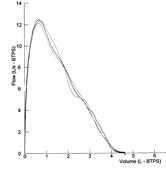SPIROMETRY
Overview
Spirometry plays an important role in an occupational respiratory health surveillance program. It can assist the health professional by determining if a worker demonstrates a specific pattern of respiratory impairment and can help to assess the effectiveness of measures implemented to protect the individual worker. In addition, results from defined groups of workers can be evaluated in relation to potential workplace hazards.
Protecting the health of individual workers is a primary objective of various workplace surveillance programs. Results from an individual should be further assessed if abnormalities are detected or if pulmonary function values show an excessive decline in comparison to the individual’s previous tests. After ruling out technical causes for low or declining pulmonary function, efforts must be made to identify the cause. If the cause is related to a workplace exposure, then steps must be taken to better control or eliminate the exposure and prevent further damage to the worker's lungs.

Public health surveillance is the ongoing, systematic collection, analysis, and interpretation of health data essential to the planning, implementation, and evaluation of public health practices, closely integrated with the timely dissemination of these data to those who need to know. The periodic evaluation of disease patterns and analysis and reporting of aggregated spirometry results are important in documenting the effectiveness of workplace exposure control efforts and in assuring the timely recognition of gaps in disease prevention.
Spirometry Training
Spirometry Training Program
The Cotton Dust Standard promulgated by the Occupational Safety and Health Administration (OSHA) gives the National Institute for Occupational Safety and Health (NIOSH) the responsibility to approve courses in spirometry for instruction of those individuals who will be administering screening pulmonary function testing to employees who are exposed to cotton dust. In addition to information on the spirometry training program, NIOSH also provides a list of course sponsors, course audit and sponsorship renewal dates, schedule of courses, and instructor resources.
Spirometry Training Guide
DHHS (NIOSH) Publication No. 2004-154c
NIOSH provides a training manual which course directors may use in whole or part. Each course director is responsible for distributing materials relevant to his or her course. A printed copy can be ordered by contacting the CDC-INFO public information contact center: Contact CDC-INFO, 1-800-CDC-INFO (1-800-232-4636), TTY: 1-888-232-6348. A Spanish translation of this training is available: http://www.cdc.gov/spanish/niosh/docs/2004-154c_sp/.
Get Valid Spirometry Results EVERY Time
DHHS (NIOSH) Publication No 2011-135
This 20” x 24” poster is intended to be used in clinical testing areas for easy reference during test administration. This document provides concise information on how to identify and correct technical and equipment errors encountered during spirometry testing, using the most current standard professional practice guidelines.
Monitoring Programs
Spirometry Monitoring Technology
Spirometry monitoring is recommended for persons with occupational exposure to respiratory hazards, and is best done as part of an overall health maintenance program in which results of spirometry evaluations are linked with exposure control, smoking cessation, and general health-promotion interventions. Spirometry monitoring should be done to prevent development of disabling chronic lung function impairment through early intervention on excessive lung function loss.
Spirometry Longitudinal Data Analysis (SPIROLA) Software
SPIROLA software is an easy-to-use visual and quantitative tool intended to assist the health care provider in monitoring and interpreting computerized longitudinal spirometry data for individuals as well as for a group.
Resources for Employers and Workers
Spirometry plays an important role in an occupational respiratory health surveillance program. Many factors contribute to the accuracy of spirometry testing including accuracy of the testing equipment and testing protocols. Both the employer and individual worker need to understand their roles in contributing to a successful respiratory surveillance program.
OSHA•NIOSH Infosheet – Maximize Your Spirometry Screening and Surveillance Resources
DHHS (NIOSH) Publication No. 2011-133
This resource is intended for employers and describes the basic information they need to understand whether the spirometry services provided for the purpose of detecting adverse outcomes from occupational exposures is conforming to accepted quality standards. A brief checklist is included that summarizes critical aspects of spirometry testing for non-medical corporate personnel.
OSHA•NIOSH Worker Info: PROTECT YOURSELF – SPIROMETRY BREATHING TEST
DHHS (NIOSH) Publication No. 2011-132
This information resource describes why spirometry is important, what to expect during the test, and the employee’s rights regarding test results.
- Page last reviewed: December 22, 2011
- Page last updated: February 18, 2016
- Content source:
- National Institute for Occupational Safety and Health Respiratory Health Division


 ShareCompartir
ShareCompartir